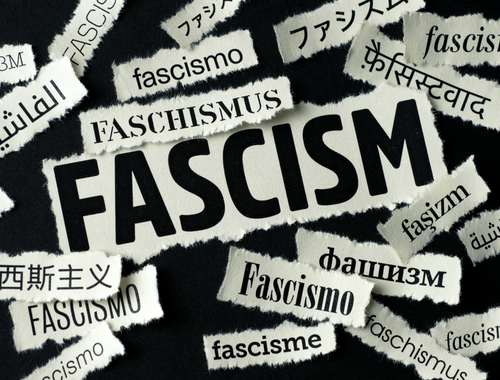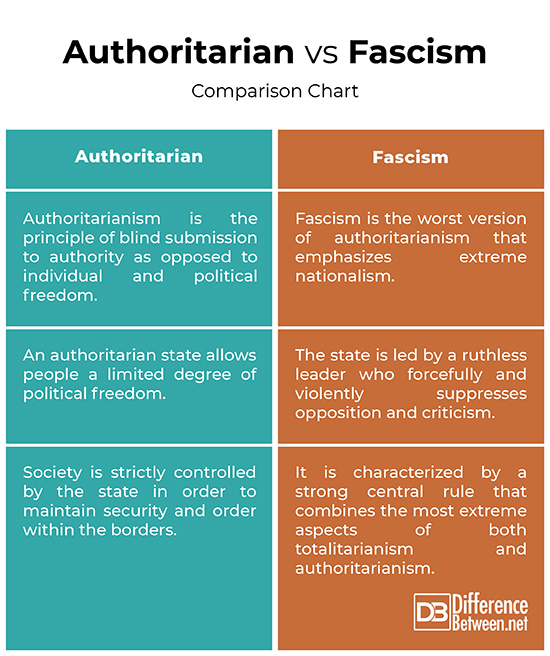Difference Between Authoritarian and Fascism
The 21st century has been tough so far and we are continuously confronted by multiple challenges – terrorism, economic crises, racism, ecological disasters, global pandemic, authoritarianism, fascism, and what not. All these problems are manifestations of the contradictions of the global capitalism emanating from the decline of empire in Europe and the United States. Today, at the beginning of the third decade of the 21st century, political rights and civil liberties around the world have deteriorated. Today, fascism and authoritarianism remain probably the vaguest of the major political terms. With the line between fascism and authoritarian being blurred these days, it is difficult to tell the difference.

Authoritarian
Authoritarianism is the principle of blind submission to authority as opposed to individual freedom. Authoritarian populism shares different ideologies wherein the rulers demand unquestionable obedience from the ruled. Authoritarian practices are about sabotaging accountability and democracy. This is done by two ways. First is lying to the public or keeping secrets from them. The second way is by suppressing voice. Even in democratic countries, journalism is often suppressed or discouraged by those in power. Governments like Syria and Iran have harassed critical voices even far beyond their borders. Authoritarianism refers to a form of government in which a society is strictly controlled by the state in order to maintain security and order within the borders. This kind of regime exercises unlimited power.

Fascism
As far as political ideologies go, none of them are more universally criticized than fascism. Although the movement was only active for a short while in a select few countries, its impact are still felt to this day. Fascism is a political philosophy or movement that emphasizes extreme nationalism that aims to create a stronger and greater society, stripped of all its weaknesses. Often this nationalism refers to the concept of racial or cultural purity as a method of weeding out weakness. It is characterized by a strong central rule that combines the most extreme aspects of both totalitarianism and authoritarianism. Fascism is typically considered to be at the far right end of the political spectrum. People are forced to have unwavering faith in a single party ruling, like a dictator. The end goal is to become fully self sufficient.
Difference between Authoritarian and Fascism
Governance
– Both authoritarianism and fascism regimes share numerous similarities, but both these ideologies differ markedly in terms of their nature. Both are forms of government characterized by a strong central rule that attempts to exercise total control of all aspects of individual life through repression and coercion. Authoritarianism typically comes first, which is like when you have a leader (more like a dictator) they take all powers, not just the ones given to them. When you live essentially under the complete rule of this regime, it becomes fascism.
Characteristics
– The authoritarianism is a form of government linked with dictatorship where the leaders take all the decisions with little or no participation from their followers or members of their team. While an authoritarian state allows people a limited degree of political freedom. Fascism is probably the worst and most extreme version of an authoritarian government where the people and the government are led by a ruthless leader who forcefully and violently suppresses opposition and criticism, emphasizing an aggressive nationalism and often racism.
Authoritarian vs. Fascism: Comparison Chart

Summary
In both authoritarianism and fascism regime, the dictatorial leader is presented as a ruthless figure who doesn’t respect political freedom and civil liberties. While an authoritarian leader is like an ideologist who has the best interest of its people in mind, a fascist leader has no regards to individual freedom and is more focused on exercising unlimited power. For a fascist, the country is more important than any group of people and even freedom. One of the most extreme examples of this is the slaughter of millions of Jews by Nazi Germany under the leadership of Adolf Hitler.
FAQ
Is authoritarianism the same as fascism?
While an authoritarian state allows people a limited degree of political freedom, a fascist leader forcefully and violently suppresses opposition and criticism, emphasizing an aggressive nationalism.
Is fascism and dictatorship the same thing?
Fascism is probably the worst and extreme level of dictatorship that is considered to be at the far right end of the political spectrum. A fascist leader believes the country is more important than the people and is above all.
What is difference between totalitarianism and authoritarianism?
Both are forms of government characterized by a strong central rule that exercises total control over all aspects of individual life through coercion and repression. However, an authoritarian state allows its citizens a limited degree of political freedom whereas a totalitarian government controls all aspects of society, economy, and politics.
What is the main idea of fascism?
Fascism is extreme nationalism that is usually characterized by authoritarianism and totalitarianism. It promotes the idea of a monolithic, regimented nation under the control of a ruthless leader.
Is fascism capitalist or socialist?
Fascism typically combines the elements of both capitalism and socialism. Fascists advocate for individual profit, anti-communism, racism, etc.
What is an example of authoritarian?
Argentina under the leadership of Juan Perón, the founder of the Peronist movement, was one of the best examples of the authoritarian regime.
Is authoritarian the same as dictatorship?
An authoritarian claims to have the best interest of its citizens in mind whereas a dictator holds virtually unlimited power without effective constitutional limitations.
- Difference Between Caucus and Primary - June 18, 2024
- Difference Between PPO and POS - May 30, 2024
- Difference Between RFID and NFC - May 28, 2024
Search DifferenceBetween.net :
Leave a Response
References :
[0]Pinto, António Costa. An Authoritarian Third Way in the Era of Fascism: Diffusion, Models and Interactions in Europe and Latin America. England, UK: Routledge, 2021. Print
[1]Berberoglu, Berch. The Global Rise of Authoritarianism in the 21st Century: Crisis of Neoliberal Globalization and the Nationalist Response. England, UK: Routledge, 2020. Print
[2]Payne, Stanley G. A History of Fascism, 1914–1945. Wisconsin, United States: University of Wisconsin Press, 1996. Print
